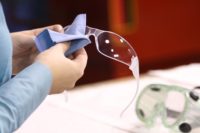If you watch or read the news, you may have seen images of healthcare providers covered head to toe in bulky garments as they treat hospital patients who have a contagious disease. During disease outbreaks, these garments, collectively called a personal protective equipment (PPE) ensemble, play a critical role in public health. PPE ensembles protect wearers from job-related exposure to disease-causing germs. They also reduce the risk that healthcare workers will become infected while treating seriously ill patients and further spread a contagion.
The problem is that PPE ensembles can also hinder the worker’s movement and comfort, particularly in extreme weather conditions, such as excessive heat. Previous research has shown that these effects can decrease physical performance and increase the risk of other injuries, like overexertion and slips, trips, and falls. Now, a new 3-year study at the National Institute for Occupational Safety and Health (NIOSH) will evaluate the precise ways that PPE might put stress on the body and, subsequently, affect comfort and job performance.
Depending upon the type of exposure, a variety of PPE options are suitable for healthcare workers, according to the Occupational Safety and Health Administration. The new National Institute for Occupational Safety and Health (NIOSH) study will evaluate a PPE ensemble commonly used to protect wearers from occupational exposure to germs, such as Ebola, which have a high risk for causing serious or fatal disease. The PPE ensemble includes several elements:
- A powered air-purifying respirator with a hood.
- A fluid-resistant or impermeable protective suit with openings taped closed.
- A double layer of gloves.
- Boots.
Areas investigated will include the PPE ensemble’s effects on walking ability and postural balance, as well as heart rate, body temperature, hydration, and inflammatory responses. The study’s long-term goals are to develop safety guidelines, such as how much rest someone needs when wearing PPE in various environments. Ultimately, the findings could lead to improved PPE design and safe work practice for healthcare workers. Voluntary enrollment of healthcare workers to participate in the study begins in 2016.
For more information about using personal protective equipment, visit Powered Air-Purifying Respirator (PAPR) and Coveralls.



